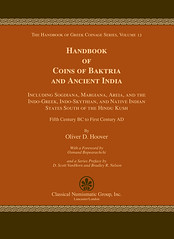
PREV ARTICLE
NEXT ARTICLE
FULL ISSUE
PREV FULL ISSUE
NEW BOOK: HANDBOOK OF COINS OF BAKTRIA AND ANCIENT INDIA
The latest volume in the Handbook of Greek Coinage series has been announced.
Thanks to the February 13, 2014 issue of CoinsWeekly for the heads' up.
Here's the information from the web ite of the book's publisher, Classical Numismatic Group.
-Editor
More than three decades have passed since David Sear published Greek Coins & Their Values, his revision of Gilbert Askew’s A Catalogue of Greek Coins published by B. A. Seaby in 1951. Since then, the field of ancient numismatics and the hobby of collecting ancient coins have changed so much that now Greek Coins & Their Values would require a complete revision to include all of the most current numismatic information available, list the many new types and varieties unknown to Sear, and determine an approximate sense of rarity for all of these issues. In order to encompass this new material and create a viable reference for the beginning and specialized collector, such a handbook would have to be more than the two volumes which Sear found necessary. As a result, Classical Numismatic Group is publishing The Handbook of Greek Coinage Series, written by Oliver D. Hoover, in a series of 13 volumes, each covering a specified area of Greek coinage with the first being The Handbook of Syrian Coins: Royal and Civic Issues, Fourth to First Centuries BC (Volume 9 in the series). This series is designed to aid the user in the quick, accurate, and relatively painless identification of Greek coins, while providing a cross-reference for each entry to a major work, which will allow the inquirer to pursue more in-depth research on the subject. The subject-matter of each volume is arranged chronologically for royal issues, and regionally for the civic issues; within each region, cities are listed directionally, depending on the region. For those rulers or cities that issued coins concurrently in all three metals, these issues will be arranged in the catalog with gold first, followed by silver, and then bronze; each metal is arranged by denomination, largest to smallest. Known mints for the royal coinage are listed below the appropriate type, making an easy search for a specific mint. Each entry will include a rarity rating based on the frequency with which they appear in publications, public and private collections, the market, and/or are estimated to exist in public or private hands. No valuations are listed, since such values are generally out of date by the time of publication. An online valuation guide at www.greekcoinvalues.com will allowing interested individuals the opportunity to gauge the market, and reduce the need for repeated updates of this series. Whether one purchases the entire set for their reference library, or the individual volume pertaining to one’s area of specialization, The Handbook of Greek Coinage Series should provide a useful staging-point from which collectors and interested scholars can pursue their research and interests. The latest published volume in the series is Handbook of Coins of Baktria and Ancient India, Including Sogdiana, Margiana, Areia, and the Indo-Greek, Indo-Skythian, and Native Indian States South of the Hindu Kush, Fifth Century Centuries BC to First Century AD (Volume 12 in the series). Beginning with the Kingdom of Baktria, the catalog covers all the Graeco-Bacrian and Indo-Greek kings. This volume includes the Indo-Skythian rulers and satraps, as well as the local coinages of the region. The Indian coinages south of the Hindu Kush are also included. While not obviously Greek coinage, these issues were struck in the context of their Greek neighbors and will add further evidence to the complex monetary systems of the region. For more information or to order a copy, see: Now at Press - Orders Being Taken (www.cngcoins.com/Coin.aspx?CoinID=245635#)
To read the CoinsWeekly article, see:
New volume in Handbook of Greek Coinage Series
(www.coinsweekly.com/en/News/4?&id=2596)
The Numismatic Bibliomania Society is a non-profit organization promoting numismatic literature. See our web site at coinbooks.org. To submit items for publication in The E-Sylum, write to the Editor at this address: whomren@gmail.com To subscribe go to: https://my.binhost.com/lists/listinfo/esylum All Rights Reserved. NBS Home Page Contact the NBS webmaster 
|
